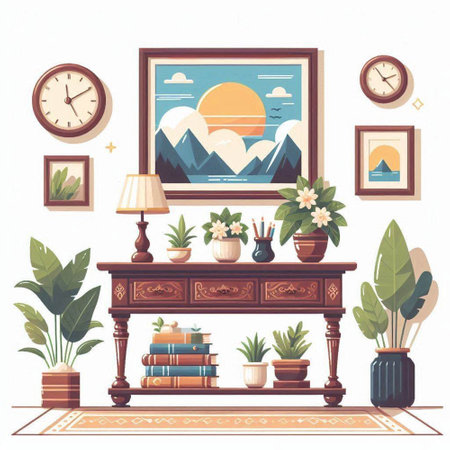Introduction to Regency and Georgian Architectural Heritage
The enduring allure of British interiors owes much to the legacy of the Regency and Georgian eras, two defining periods that have shaped the nation’s architectural and aesthetic sensibilities. Spanning from the early 18th century through to the early 19th century, these eras were marked by significant cultural and social shifts, leaving a profound imprint on Britain’s built environment. The Georgian era, renowned for its elegance and symmetry, introduced classical influences—think stately townhouses, grand crescents, and harmonious proportions—while the Regency period embraced a lighter, more playful refinement, with an emphasis on delicate ornamentation and increased use of colour. Together, these epochs represent a golden age in British architectural history, setting standards of taste and sophistication that resonate in modern design choices today. As we explore how their historical context informs current paint selections, it becomes clear that the subtle hues, restrained palettes, and striking contrasts favoured during these times continue to inspire homeowners seeking timeless British style.
2. Iconic Colour Palettes of the Eras
The Regency and Georgian periods are celebrated for their distinctive colour palettes, which continue to influence modern paint choices in British interiors. These eras each brought forth unique hues and combinations, shaped not only by evolving aesthetic preferences but also by advances in pigment technology and shifts in societal ideals.
Georgian Era: Subtle Sophistication
During the Georgian era (1714–1830), interiors were characterised by a sense of order, symmetry, and refinement. The use of soft, muted tones reflected Enlightenment values—rationality, restraint, and harmony. Popular shades included delicate blues, sage greens, stone greys, and gentle creams. Such colours were often chosen to complement the classical architectural details of the time, highlighting plasterwork and panelling with understated elegance.
Typical Georgian Colour Palette
| Colour | Description | Societal Reflection |
|---|---|---|
| Pale Blue | Soft, powdery blue reminiscent of Wedgwood ceramics | Symbolised tranquillity and intellectual clarity |
| Sage Green | Earthy green with grey undertones | Echoed the period’s connection to nature and rational design |
| Stone Grey | Neutral, warm grey | Signified stability and balance within the home |
| Cream | Warm off-white shade | Conveyed understated luxury and lightness |
Regency Era: Bold Elegance and Innovation
The Regency period (1811–1820) saw a shift towards richer, more dramatic colours inspired by global influences and technological progress in pigment production. This era embraced opulent hues such as deep emerald greens, rich burgundies, vibrant yellows, and striking blacks. Advances in paint manufacturing allowed for brighter pigments, making bold contrasts possible within the home—a reflection of both imperial ambition and a growing taste for theatricality.
Popular Regency Colour Combinations
| Main Colour | Accent Pairings | Cultural Significance |
|---|---|---|
| Emerald Green | Burnished golds, ivory whites | Suggested prosperity and cosmopolitan sophistication |
| Burgundy Red | Cream or black detailing | Evinced drama and opulence in entertaining spaces |
| Sulphur Yellow | Rich blue or charcoal trim | Displayed a flair for innovation and vibrancy |
| Glossy Black | Pearl grey or crisp white highlights | Brought modernity into classical settings while framing architectural features |
The Lasting Legacy on Modern Interiors
The careful curation of these historical palettes was more than just an aesthetic choice—it spoke volumes about societal aspirations and technological possibilities. Today’s British homes often echo these iconic colour stories, blending the subtlety of Georgian tones with the confident contrasts favoured during the Regency era to create spaces that are both timeless and distinctly contemporary.

3. Modern Paint Choices Inspired by Historical Tones
Today’s designers and homeowners across the UK are increasingly turning to Regency and Georgian colour palettes to inform their modern interiors, crafting spaces that feel both timeless and relevant. This revival is not about replicating period rooms, but rather reimagining classic elements for contemporary lifestyles. The serene, chalky blues, gentle sage greens, and soft off-whites—once reserved for stately drawing rooms or elegant townhouses—are now chosen for living rooms, kitchens, and even bathrooms to evoke a sense of sophistication and calm. By pairing these historical tones with modern furnishings or minimalist layouts, designers achieve a balanced aesthetic that honours the past without feeling antiquated.
Contemporary Interpretations of Classic Hues
Modern British paint brands often reinterpret Regency and Georgian colours with updated formulations, offering matt finishes or environmentally friendly options that suit today’s practical needs. Homeowners appreciate how these hues bring subtle warmth and depth to open-plan spaces, while still allowing for personal expression through accent walls or trim details. Layering these heritage-inspired shades with natural materials like oak flooring or marble countertops further bridges the gap between old-world charm and contemporary comfort.
Creating Characterful Spaces
The enduring appeal of Regency and Georgian colours lies in their versatility. Soft celadon greens can brighten north-facing rooms, while dusky pinks add gentle drama to bedrooms or studies. Whether used as a backdrop for curated artwork or as a statement on panelled walls, these historical shades lend character and narrative to even the most modern homes. Ultimately, drawing from this rich palette allows British interiors to feel both rooted in tradition and refreshingly current—a testament to the lasting influence of these iconic design eras.
4. British Brands and Paints: A Nod to the Past
British heritage paint companies play a pivotal role in reviving the elegance of Regency and Georgian eras within modern homes. Their influence extends far beyond product formulation, shaping contemporary tastes through meticulous attention to historical detail and authentic colour recreation. These venerable brands—such as Farrow & Ball, Little Greene, and Edward Bulmer Natural Paint—have become synonymous with timeless British style by drawing inspiration from the refined palettes that once adorned stately homes and townhouses.
The Legacy of Heritage Paint Companies
Many leading UK paint houses have origins dating back centuries or have developed their ranges in close collaboration with conservation experts and historic institutions. They often reference original paint archives, period documents, and architectural fragments to ensure true-to-era accuracy. This heritage-driven approach resonates deeply with homeowners who value authenticity alongside quality.
Celebrating History Through Colour Collections
Modern collections frequently feature evocative names and nuanced shades that echo the sophistication of bygone eras. Marketing materials often highlight connections to prominent figures, landmark buildings, or cultural movements of the Regency and Georgian periods. The table below illustrates how selected British brands pay homage to this legacy:
| Brand | Signature Collection | Historical Inspiration |
|---|---|---|
| Farrow & Ball | Estate Emulsion | Inspired by stately homes; includes hues like “Oval Room Blue” and “Pavilion Gray” |
| Little Greene | Georgian Collection | Collaboration with English Heritage; authentic 18th-century shades such as “Celestial Blue” |
| Edward Bulmer Natural Paint | Regency Palette | Sustainable pigments; colours directly referencing Regency mansions and decorative arts |
A Timeless Appeal for Modern Spaces
This thoughtful revival of classic palettes empowers today’s homeowners and designers to create spaces that blend modern functionality with historical charm. By choosing paints steeped in heritage, they participate in a tradition of elegance that bridges centuries, ensuring that the refined spirit of Regency and Georgian Britain endures in contemporary interiors.
5. Implementing Heritage Hues in Modern British Homes
Bringing the timeless elegance of Regency and Georgian palettes into contemporary British interiors is an artful way to bridge past and present. Whether you own a listed townhouse in Bath, a Victorian terrace in Manchester, or a new-build flat in London, heritage-inspired paint colours can elevate your space with historical sophistication while suiting modern lifestyles.
Tailoring Paint Choices to Period Properties
For homeowners blessed with original features—think cornicing, sash windows, or panelled doors—leaning into authentic Regency and Georgian shades enhances these architectural treasures. Soft stone greys, muted duck-egg blues, and classic off-whites complement intricate plasterwork and high ceilings without overpowering them. Consider painting woodwork in gentle contrasts: for example, pairing a deep olive green on skirtings with pale limestone walls evokes subtle grandeur reminiscent of stately homes.
Adapting Heritage Palettes for New Builds
If your home is more modern in construction, integrating these hues is about creating atmosphere rather than strict period accuracy. Pale celadon greens or powder blues bring a sense of calm and character to open-plan living spaces. Try using richer tones—such as ochre or smoky teal—as accent walls or within alcoves to echo the boldness of Regency dining rooms. Don’t shy away from layering textures: matte finishes on walls paired with gloss on architraves or cabinetry lend visual interest that nods to historical techniques.
Practical Tips for Diverse British Home Styles
In compact urban flats, lighter Georgian tones can amplify natural light and make spaces feel airy; meanwhile, deeper Regency colours add intimacy to cottages or semi-detached houses. For those embracing the current trend for biophilic design, historic greens and earthy taupes pair beautifully with indoor plants and natural materials. Remember to factor in the unique light quality of your region—northern cities may benefit from warmer undertones, while brighter southern exposures suit cooler shades.
Ultimately, weaving Regency and Georgian influences into your home’s palette is not about rigidly replicating the past but reimagining it for today’s Britain. By honouring heritage hues within any property type, you create rooms that are both rooted in tradition and attuned to contemporary life.
6. Conclusion: Timeless Elegance for Contemporary Spaces
The continued resonance of Regency and Georgian eras within modern British interiors speaks to the enduring allure of their refined aesthetics. These historic periods, with their emphasis on balance, proportion, and sophisticated colour palettes, have left an indelible mark on today’s paint choices. Modern designers and homeowners alike draw inspiration from the soft yet impactful hues, crisp architectural details, and sense of understated grandeur that characterise these influential eras.
In contemporary spaces, the fusion of classic Regency blues, Georgian greys, and muted pastels with sleek lines and minimalist furnishings creates a dialogue between past and present. This blend not only evokes nostalgia but also reinforces a distinctly British approach to elegance—one that values heritage as much as innovation. The popularity of period-inspired paints such as dove grey, duck egg blue, and subtle sage green demonstrates how these historical influences are perfectly suited for today’s lifestyles, bringing warmth, depth, and a touch of aristocratic charm to urban flats and country homes alike.
Ultimately, Regency and Georgian influences remain pivotal in shaping modern British aesthetics. Their timeless appeal lies in their adaptability; whether used as a backdrop for eclectic contemporary art or paired with traditional mouldings, these colours serve as a bridge connecting centuries of style. In embracing this heritage, today’s interiors achieve a sense of continuity—an enduring elegance that transcends trends and celebrates the best of British design.


